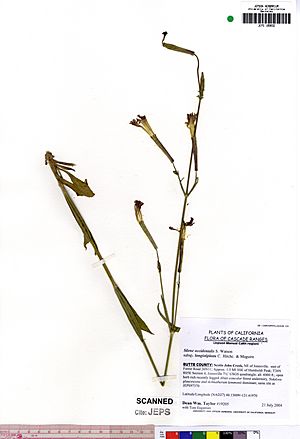Western catchfly facts for kids
Quick facts for kids Western catchfly |
|
|---|---|
 |
|
| Herbarium specimen, subsp. longistipata | |
| Scientific classification | |
| Genus: |
Silene
|
| Species: |
occidentalis
|
Silene occidentalis, also called western catchfly or western campion, is a type of flowering plant. It belongs to the Caryophyllaceae family, which includes many kinds of pinks and carnations.
This plant is special because it is endemic to northern California. This means it naturally grows only in this specific area and nowhere else in the world. You can find it in the southern Cascade Range, parts of the Modoc Plateau, and the Sierra Nevada mountains. It likes to grow in chaparral (a type of shrubland) and mountain forests.
What Does Western Catchfly Look Like?
Silene occidentalis is a plant that lives for many years, which means it is a perennial. It grows from a strong, woody base called a caudex and has a main root that grows straight down, known as a taproot.
Stems and Leaves
The plant sends up a straight stem that usually does not have many branches. This stem can grow up to 60 centimeters (about 2 feet) tall. Its leaves are shaped like a spear and can be up to 12 centimeters (about 5 inches) long near the bottom of the plant. Leaves higher up on the stem are usually shorter.
Flowers and Petals
The flowers of the western catchfly grow in a cluster at the top of the stem. Sometimes, flowers also appear where the leaves meet the stem. Each flower is wrapped in a hairy, sticky outer layer called a calyx. This calyx is made of sepals that have grown together.
In one type of this plant, called subspecies longistipata, the calyx can be very long, almost 4 centimeters (about 1.5 inches). At the end of the calyx, there are five pink petals. Each petal usually has four fringed or ragged edges at its tip, making them look unique.

